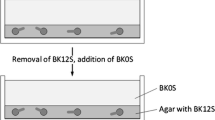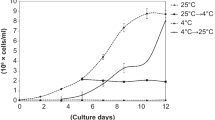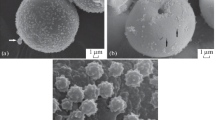Summary
Energy-driven protein secretion from Petunia hybrida pollen in 10% sucrose solution shaking culture does not change markedly with temperature, except over a narrow (6° C) temperature range with a midpoint at 17° C. Over this narrow temperature range, there is a very rapid increase from a low secretion plateau at low temperatures to a plateau of higher secretion at higher temperatures. Addition of calcium ions decreases the overall amount secreted, but does not change the critical temperature where the rapid rise in secretion is observed. Boric acid, when added to the culture, also decreases the overall amount released, but in a different way to calcium. While there is a sharp discontinuity at 17° C as before, the increase in protein release at this temperature is smaller than before. In addition, after a plateau at temperatures higher than 20° C, there is a second sharp increase in secreted protein over another narrow temperature range with a midpoint of 28° C, followed by another plateau at higher temperatures. The effects of calcium and boric acid are additive. The sharp discontinuities in protein release are interpreted in terms of lipid thermotropism in membranes and a boron involvement in the movement of proteins into the extending pollen tube membranes from secretory vesicles.
Similar content being viewed by others
References
Belver A, Donaire JP (1987) Phospholipid metabolism in roots and microsomes of sunflower seedlings: inhibition of choline phosphotransferase activity by boron. Phytochemistry 26:2923–2927
Birnbaum EH, Dugger WM, Beasley BCA (1977) Interaction of boron with components of nucleic acid metabolism in cotton ovules cultured in vitro. Plant Physiol 59:1034–1038
Bradford MM (1976) A rapid and sensitive method for quantitation of microgram quantities of protein utilizing the principle of protein-dye binding. Anal Biochem 72:248–254
Chapman KSR, Jackson JF (1974) Increased RNA labelling in boron deficient root-tip segments. Phytochemistry 13:1311–1318
Gilissen LJW (1977) The influence of relative humidity on the swelling of pollen grains in vitro. Planta 137:299–301
Glick BS, Rothman JE (1987) Possible role for fatty acyl-coenzyme A in intracellular protein transport. Nature 326:309–312
Gruenberg JE, Howell KE (1986) Reconstitution of vesicle fusions occurring in endocytosis with a cell-free system. EMBO J 5:3091–3101
Jackson JF, Chapman KSR (1975) The role of boron in plants. In: Nicholas DJD, Egan AR (eds) Trace elements in soilplant-animal systems. Academic Press, New York London, pp 213–215
Jackson JF, Linskens HF (1978) Evidence for DNA repair after ultraviolet irradiation of Petunia hybrida pollen. Mol Gen Genet 161:117–120
Jackson JF, Linskens HF (1979) Pollen DNA repair after treatment with the mutagens 4-nitroquinoline-1-oxide, ultraviolet and near-ultraviolet irradiation, and boron dependence of repair. Mol Gen Genet 176:11–16
Johnson KP, Chrispeels MJ (1987) Substrate specificities of N-acetylglucosaminyl-, fucosyl-, and xylosyltransferases that modify glycoproteins in the golgi apparatus of bean cotyledons. Plant Physiol 84:1301–1303
Kamboj RK, Jackson JF (1984) Divergent transport mechanisms for pyrimidine nucleosides in Petunia pollen. Plant Physiol 75:499–501
Kamboj RK, Jackson JF (1985) Pyrimidine nucleoside uptake by Petunia pollen. Specificity and inhibitor studies on the carrier-mediated transport. Plant Physiol 79:801–805
Kamboj RK, Jackson JF (1986) Self-incompatibility alleles control a low molecular weight, basic protein in pistils of Petunia hybrida. Theor Appl Genet 71:815–819
Kamboj RK, Jackson JF (1987) Purine nucleoside transport in Petunia pollen is an active, carrier-mediated system not sensitive to nitrobenzylthionosine and not renewed during pollen tube growth. Plant Physiol 84:688–692
Kamboj RK, Linskens HF, Jackson JF (1984) Energy-driven protein release from germinating pollen of Petunia hybrida. Ann Bot (London) 54:647–652
Parr AJ, Loughman BC (1983) Boron and membrane function in plants. In: Robb PR, Pierpoint WS (eds) Metals and micronutrients: uptake and utilization by plant. Academic Press, London New York, pp 87–107
Picton JM, Steer MW (1983) Membrane recycling and the control of secretory activity in pollen tubes. J Cell Sci 63:303–310
Pollard AS, Parr AJ, Loughman BC (1977) Boron in relation to membrane function in higher plants. J Exp Bot 28:831–837
Staehelin LA, Chapman RL (1987) Secretion and membrane recycling on plant cells. Planta 171:43–57
Stanley RG, Linskens HF (1965) Protein diffusing from germinating pollen. Physiol Plant 18:47–53
Tanada T (1974) Boron-induced bioelectric field change in Mung bean hypocotyl. Plant Physiol 53:775–776
Thilo L, Trauble H, Overath P (1977) Mechanistic interpretations of the influence of lipid phase transitions on transport functions. Biochemistry 16:1283–1290
Wunderlich F, Kreutz W, Mahler P, Ronai A, Heppeler A (1978) Thermotropic fluid to ordered discontinuous phase separation in microsomal lipids of tetrahymena. An X-ray diffraction study. Biochemistry 17:2005–2010
Zittle CA (1951) Reaction of borate with substances of biological interest. Adv Enzymol 12:493–527
Author information
Authors and Affiliations
Rights and permissions
About this article
Cite this article
Jackson, J.F. Borate control of protein secretion from Petunia pollen exhibits critical temperature discontinuities. Sexual Plant Reprod 2, 11–14 (1989). https://doi.org/10.1007/BF00190113
Issue Date:
DOI: https://doi.org/10.1007/BF00190113




